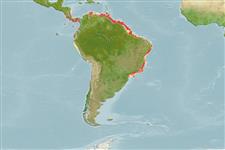Environment: milieu / climate zone / depth range / distribution range
Ecologia
marinhas; Água doce; estuarina; intervalo de profundidade 1 - 55 m, usually 5 - 30 m (Ref. 9298). Tropical; 14°N - 26°S, 87°W - 32°W (Ref. 189)
Western Atlantic: Panama to Trinidad and south to at least Santos, Brazil, perhaps further. Eastern Pacific: Costa Rica to the northern border of Peru at 3°34'S, perhaps further. Also found in freshwater.
Tamanho / Peso / Idade
Maturity: Lm ? range ? - ? cm
Max length : 24.0 cm TL macho/indeterminado; (Ref. 5217); common length : 20.0 cm TL macho/indeterminado; (Ref. 5217); peso máx. publicado: 66.30 g (Ref. 118626)
Espinhos dorsais (total): 0; Espinhos anais 0; Raios anais : 31 - 37. Snout about 3/4 eye diameter; maxilla long, tip pointed, reaching to or a little beyond edge of gill cover; anterior gill rakers mere stumps; hind border of gill cover with a small triangular projection; panamensis-type gill cover canals. Pectoral fin long; anal fin origin below midpoint of dorsal fin base. A silver stripe along flank in small individuals, disappearing with age (Ref. 189).
A coastal species that apparently forms large schools. Enters brackish and fresh waters. Feeds on small fishes (including clupeoids) and prawns (Ref. 12225). Seems to spawn over an extended period in Costa Rica (small fishes caught in February, September and October). Marketed fresh (Ref. 9298).
Ciclo de vida ou comportamento de acasalamento
Maturidade | Reprodução | Desova | Ovos | Fecundidade | Larvas
Probably an extended spawning season in Costa Rica (small fishes caught in February, September and October (Ref. 189). Spawn in school (Ref. 205).
Whitehead, P.J.P., G.J. Nelson and T. Wongratana, 1988. FAO Species Catalogue. Vol. 7. Clupeoid fishes of the world (Suborder Clupeoidei). An annotated and illustrated catalogue of the herrings, sardines, pilchards, sprats, shads, anchovies and wolf-herrings. FAO Fish. Synop. 125(7/2):305-579. Rome: FAO. (Ref. 189)
Status na Lista Vermelha da UICN (Ref. 130435)
Ameaça para os humanos
Harmless
Uso pelos humanos
Pescarias: pouco comercial
Mais informação
ReferênciasAquaculturaPerfil para aquaculturaEstirpesGenéticaElectrophoresesHereditariedadeDoençasProcessamentoNutrientsConversão de massa
ColaboradoresFotosStamps, Coins Misc.SonsCiguateraVelocidadeTipo de nataçãoÁrea branquialOtólitosCérebrosVisão
Ferramentas
Relatórios especiais
Baixar XML
Fontes da internet
Estimates based on models
Preferred temperature (Ref.
123201): 25.2 - 28.2, mean 27.4 °C (based on 122 cells).
Índice de diversidade filogenética (Ref.
82804): PD
50 = 0.5000 [Uniqueness, from 0.5 = low to 2.0 = high].
Bayesian length-weight: a=0.00457 (0.00296 - 0.00706), b=3.17 (3.05 - 3.29), in cm total length, based on LWR estimates for this species & Genus-body shape (Ref.
93245).
Nível Trófico (Ref.
69278): 4.1 ±0.71 se; based on food items.
Resiliência (Ref.
120179): Elevada, tempo mínimo de duplicação da população menor que 15 meses (Preliminary K or Fecundity.).
Fishing Vulnerability (Ref.
59153): Low vulnerability (14 of 100).
Nutrients (Ref.
124155): Calcium = 188 [109, 440] mg/100g; Iron = 1.38 [0.74, 2.46] mg/100g; Protein = 17.8 [15.4, 20.5] %; Omega3 = 0.338 [0.163, 0.725] g/100g; Selenium = 40.5 [18.0, 103.2] μg/100g; VitaminA = 19.3 [5.6, 54.8] μg/100g; Zinc = 1.51 [1.04, 2.18] mg/100g (wet weight);
